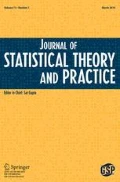Abstract
Due to its simplicity and operational convenience, systematic sampling is one of the most prevalent sampling techniques. However, this sampling design has two main statistical drawbacks. First, the actual sample size is unfixed when the population size, N, is not an integral multiple of the desired sample size, n. Second, the sampling variance cannot be unbiasedly estimated on the basis of a single systematic sample. In this article we introduce a new generalized systematic sampling design that handles these two issues simultaneously. The proposed design combines the remainder linear systematic sampling design, which handles only the first problem, along with the idea of multistart systematic sampling that provides an unbiased estimator for the sampling variance. Unbiased estimators for both the finite population mean and the sampling variance are derived under the proposed design. The performance of the new design is evaluated relative to another six sampling schemes under several superpopulation models and real populations. Further, the stability of the proposed sampling variance estimator is studied. Applications of the suggested design are also discussed.
Similar content being viewed by others
References
Chang, H., and K. Huang. 2000. Remainder linear systematic sampling. Sankhyā B 62:249–56.
Chaudhuri, A., and H. Stenger. 2005. Survey sampling: Theory and methods. London, UK: Chapman & Hall/CRC.
Cho, E., M. J. Cho, and J. Eltinge. 2004. The variance of sample variance from finite population. Proceedings of Joint American Statistical Association and International Statistical Institute Conference, 3345–3350, Toronto, Canada.
Cochran, W. G. 1946. Relative accuracy of systematic and stratified random samples for a certain class of populations. Annals of Mathematical Statistics 17:164–77.
Cochran, W. G. 1977. Sampling techniques. New York, NY: John Wiley & Sons.
Gautschi, W. 1957. Some remarks on systematic sampling. Annals of Mathematical Statistics 28:385–94.
Food and Agriculture Organization of the United Nations. 2010. Global forest resources assessment 2010: Main report. Rome: Italy. http://www.fao.org/docrep/013/i1757e/i1757e.pdf (accessed December 2013).
Horvitz, D. G., and D. J. Thompson. 1952. A generalization of sampling without replacement from a finite universe. Journal of the American Statistical Association 47:663–85.
Huang, K. 2004. Mixed random systematic sampling designs. Metrika 59:1–11.
Iachan, R. 1983. Asymptotic theory of systematic sampling. Annals of Statistics 11:959–69.
Isaki, C. T., and W. A. Fuller. 1982. Survey design under the regression superpopulation model. Journal of the American Statistical Association 77:89–96.
Lahiri, D. B. 1951. A method for selection providing unbiased estimates. International Statistical Association Bulletin 33:133–40.
Leu, C., and K. Tsui. 1996. New partially systematic sampling. Statistica Sinica 6:617–30.
Levy, S., and S. Lemeshow. 2008. Sampling of populations: Methods and applications. New York, NY: John Wiley & Sons.
Madow, W. G., and L. H. Madow. 1944. On the theory of systematic sampling, I. Annals of Mathematical Statistics 25:1–24.
Murthy, M. N. 1967. Sampling theory and methods. Calcutta, India: Statistical Publishing Society.
Murthy, M. N., and T. J. Rao. 1988. Systematic sampling with illustrative examples. Handbook of Statistics 6:147–85.
Nixon, M. G., M. J. Brick, G. Kalton., and H. Lee. 1998. Alternative variance estimation methods for the NHIS. Proceedings of the American Statistical Association, Survey Research Methods Section, 326–31.
Obsorne, J. G. 1942. Sampling errors of systematic and random surveys of cover-type areas. Journal of the American Statistical Association 37:256–64.
R Development Core Team. 2011. R: A language and environment for statistical computing. R Foundation for Statistical Computing. Vienna, Austria. http://www.R-project.org.
Sampath, S., and S. Ammani. 2010. Some systematic sampling strategies using multiple random starts. Pakistan Journal of Statistic and Operation Research 6 (2):149–62.
Särndal, C. E., B. Swensson., and J. Wretman. 1992. Model assisted survey sampling. New York, NY: Springer-Verlag.
Singh, D., and P. Singh. 1977. New systematic sampling. Journal of Statistical Planning and Inference, 1 (2): 163–77.
Subramani, J. 2000. Diagonal systematic sampling scheme for finite populations. Journal of the Indian Society of Agricultural Statistics 53 (2):187–95.
Subramani, J., and S. N. Gupta. 2014. Generalized modified linear systematic sampling scheme for finite populations. Hacettepe Journal of Mathematics and Statistics 43 (3):529–42.
Subramani, J., S. N. Gupta, and G. Prabavarthy. 2014. Circular systematic sampling in the presence of linear trend. American Journal of Mathematical and Management Sciences 33 (1):1–19.
Subramani, J., and S. Singh. 2014. Estimation of population mean in the presence of linear trend. Communications in Statistics—Theory and Methods 43 (15):3095–116.
Wolter, K. M. 2007. Introduction to variance estimation. New York, NY: Springer-Verlag.
Yates F., and P. Grundy. 1953. Selection without replacement from within strata with probability proportional to size. Journal of the Royal Statistical Society 15:253–61.
Zinger, A. 1980. Variance estimation in partially systematic sampling. Journal of the American Statistical Association 75:206–11.
Author information
Authors and Affiliations
Corresponding author
Rights and permissions
About this article
Cite this article
Mostafa, S.A., Ahmad, I.A. Remainder linear systematic sampling with multiple random starts. J Stat Theory Pract 10, 824–851 (2016). https://doi.org/10.1080/15598608.2016.1231094
Received:
Accepted:
Published:
Issue Date:
DOI: https://doi.org/10.1080/15598608.2016.1231094




